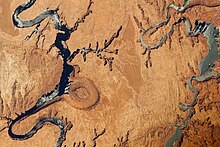Horseshoe Bend (Arizona)

Horseshoe Bend is a horseshoe-shaped incised meander of the Colorado River located near the town of Page, Arizona, United States.[1] It is also referred to as the "east rim of the Grand Canyon."[2]
Horseshoe Bend is located 5 miles (8.0 km) downstream from the Glen Canyon Dam and Lake Powell within Glen Canyon National Recreation Area, about 4 miles (6.4 km) southwest of Page.[1][3]
It is accessible via hiking a 1.5-mile (2.4 km) round trip from a parking area just off U.S. Route 89 within southwestern Page.[1] The land south of the Bend's parking area, trail, and overlook are on the Navajo Nation territory.[4]

Horseshoe Bend can be viewed from the steep cliff above.[5]
The overlook is 4,200 feet (1,300 m) above sea level, and the Colorado River is at 3,200 feet (980 m) above sea level, making it a 1,000-foot (300 m) drop.[5]
Recently, the lookout has become a major tourist destination. By 2018, references to the location on social media had caused the number of visitors to increase significantly.[6]
Geology
Horseshoe Bend is a superb example of a entrenched meander.[1] Six million years ago,[7][8] the region around Horseshoe Bend was much closer to sea level, and the Colorado River was a meandering river with a nearly level floodplain. Between six[9][10] and five[1] million years ago, the region began to be uplifted. This trapped the Colorado River in its bed, and the river rapidly cut downwards to produce Horseshoe Bend as we see it today.[1]
The cause of this uplift is still a matter of research.[11][12] One hypothesis is that uplift was a result of delamination, where the lowest layer of the North American tectonic plate below the Colorado Plateau detached and sank into the underlying mantle. This would have allowed hotter rock from the asthenosphere, the part of the earth's mantle that underlies its tectonic plates, to rise and lift the overlying crust.[10] Another possibility is that the uplift was the result of heating at the base of the crust. This transformed the lowest crustal rock from eclogite, a relatively dense rock (3.6 g/cm3) to garnet granulite, which is significantly less dense (2.9 g/cm3). This would have produced the buoyant forces needed to uplift the region.[13]
Whatever the cause of the uplift, it resulted in the erosion of up to a mile of overlying sediments from the eastern Grand Canyon.[11] This exposed the Navajo Sandstone, the surface rock found throughout the Horseshoe Bend area,[1] which also forms the entire depth of the canyon walls of the Grand Canyon at Horseshoe Bend.[14] This sandstone is notable for its crossbedding and iron concretions.[1]

It is likely that the Colorado River will eventually cut through the neck of the bend, producing a natural bridge like those found at Natural Bridges National Monument in Utah.[1] The river will then abandon Horseshoe Bend, leaving a cutoff meander resembling The Rincon further north along the Colorado River in Utah.
References
- ^ a b c d e f g h i "Horseshoe Bend Hiking Guide" (PDF). National Park Service. October 2007. Archived from the original (PDF) on February 9, 2017. Retrieved November 26, 2014.
- ^ "The Truth About Visiting Horseshoe Bend in Page, AZ". Backstreet Nomad. 2019-06-18. Retrieved 2020-07-19.
- ^ "Horseshoe Band". yourhikeguide.com. June 11, 2015. Archived from the original on June 6, 2017. Retrieved December 14, 2017.
- ^ Page, Mailing Address: PO Box 1507; MST, AZ 86040 Phone:608-6200 Receptionist available at Glen Canyon Headquarters from 7 am to 4 pm; Us, Monday through Friday The phone is not monitored when the building is closed Contact. "Horseshoe Bend - Glen Canyon National Recreation Area (U.S. National Park Service)". www.nps.gov. Retrieved 2020-07-19.
{{cite web}}: CS1 maint: numeric names: authors list (link) - ^ a b "Horseshoe Bend". visitarizona.com. Archived from the original on April 11, 2017. Retrieved December 14, 2017.
- ^ Craven, Scott (August 9, 2018). "How Horseshoe Bend Went Viral and What's Being Done to Manage the Crowds". The Arizona Republic. Retrieved August 16, 2018.
- ^ Ranney, Wayne (2012). Carving Grand Canyon : evidence, theories, and mystery (2nd ed.). Grand Canyon, Ariz.: Grand Canyon Association. ISBN 9781934656365.
- ^ Fillmore, Robert (2010). Geological evolution of the Colorado Plateau of eastern Utah and western Colorado, including the San Juan River, Natural Bridges, Canyonlands, Arches, and the Book Cliffs. Salt Lake City: University of Utah Press. p. 304. ISBN 9781607810049.
- ^ Fillmore 2010, pp. 304–305.
- ^ a b Ranney 2012, p. 113.
- ^ a b Ranney 2012, p. 110.
- ^ Fillmore 2010, pp. 304–308.
- ^ Fillmore 2010, pp. 305–306.
- ^ Phoenix, D.A. (1963). Geology of the Lees Ferry area, Coconino County, Arizona (Report). Vol. 1137. U.S. Geological Survey. doi:10.3133/b1137. Retrieved 23 September 2020.
